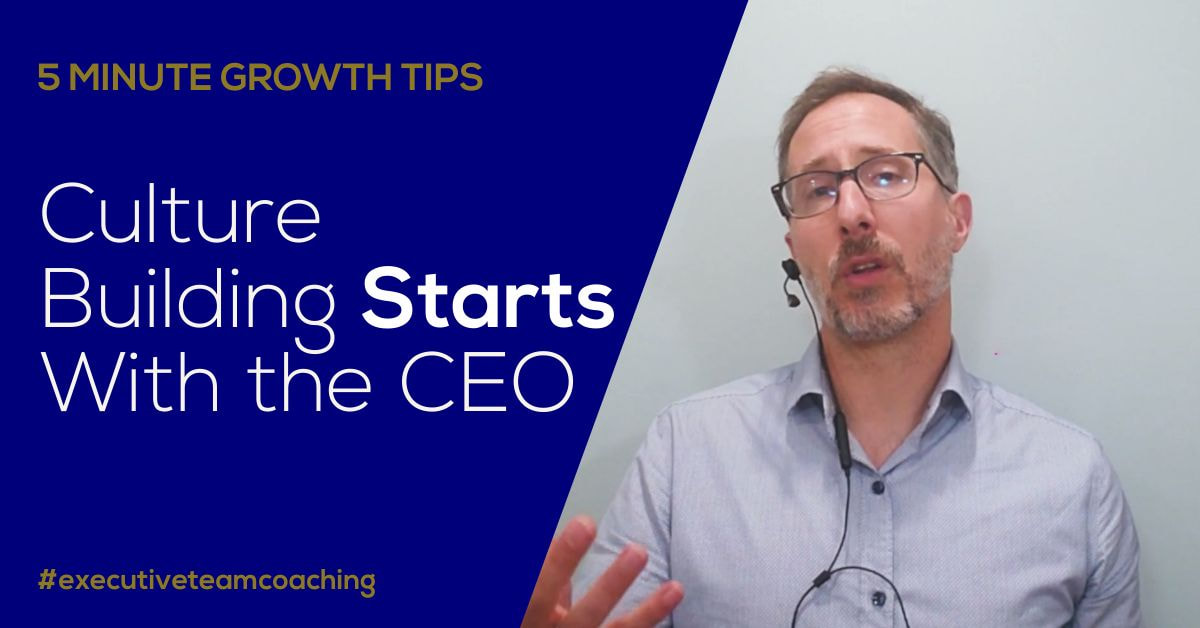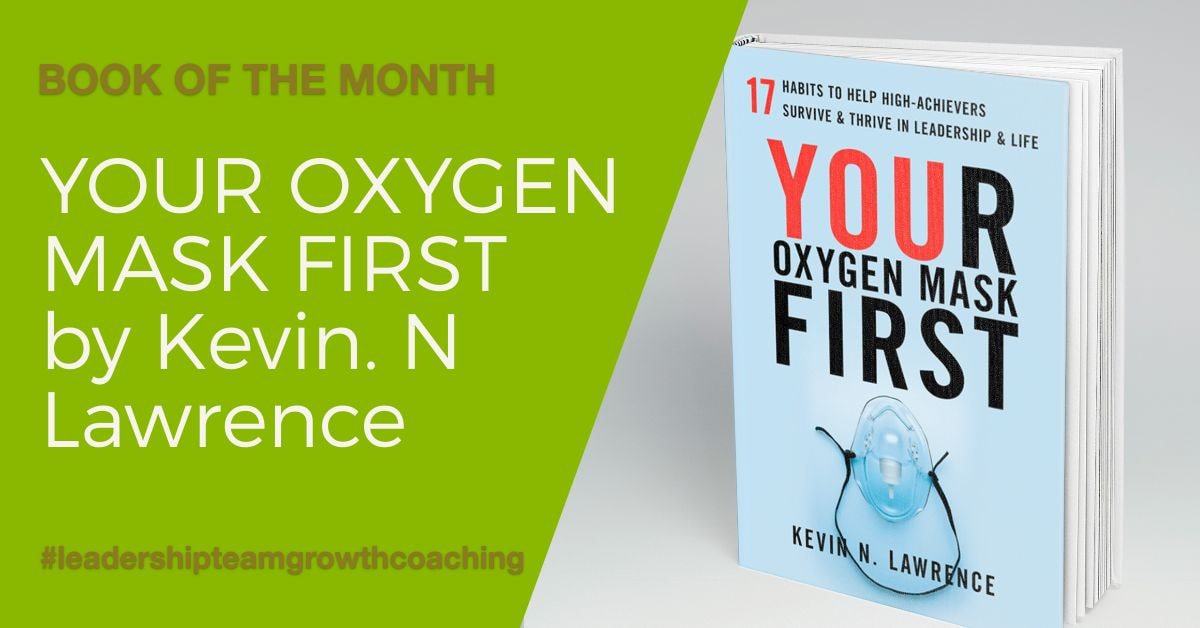|
In my work with the CEOs and Executive Teams of mid-size companies, I’ve often met CEOs who think it’s HR’s job to build the culture. They say “Oh that’s people stuff – so that’s HR’s job.” And that’s a big mistake. It’s actually the CEO’s job. Why is that? As the first featured speaker on Innovation Place’s new Brain Bites mini-video series, I shared what my colleagues and I have seen and what we teach as executive team coaches on this topic. Watch the 4 minute video here, or read the article below. The fundamentals
Let’s start with what culture really is, why it’s important, and how we build it. When you strip it all down, a company’s culture is how people, in the company, behave. Culture is important because the more that people behave in similar ways in a company, the faster the company moves. The more peoples’ behaviours are different, the more unproductive conflict there is and the slower the company moves. This is what a strong culture means. it’s one where people behave in similar ways. How do we create a strong culture? With core values. What are core values, really? Core values are a handful of rules we define to help, guide, employees’ behaviour – our culture. To get people to behave in similar ways, according to the core values – meaning to build a strong culture – the leaders have to do 3 things: - define the core values - repeat them often - live by them themselves Culture comes from leaders’ beliefs One mistake companies often make is they come up with core values that are about who they want to be, what sounds impressive, or what would look nice on their website. But that doesn’t work. Because the leaders won’t behave according to those core values, because they don’t believe in them. If the leaders don’t believe in them and don’t live them, employees won’t either. Because employees don’t do what leaders say, they do what leaders do. So if you want your company’s core values to help guide your employees to do what you do, the core values need to reflect what you really believe, and you need to behave according to those core values. HR can support, but the CEO should lead Putting HR in charge of culture takes this process out of the hands of those who really need to own it and lead it – the senior leadership team. And who needs to own the core values the most and believe in them the most? the CEO. Because the CEO will need to be the top ambassador of the core values, live those values him or her self fanatically, and hold the executive team members accountable to live them too. HR can support the CEO and leadership team’s culture building activities. And certainly, HR’s processes and policies, like employee selection and performance evaluation, need to align with the core values to help build a strong culture. But every process and policy, in every function or department, needs to align with the core values, not just HR. And even more important than the processes and policies is how the leadership team members behave – starting with the CEO. If those behaviours match our core values, people in the company will behave in similar ways – that is, the culture will get stronger, and the company will move faster. What if the CEO is too busy? If you’re a CEO, you may be thinking “but i’m too busy to build the culture”. Maybe so. And why are you too busy? Are you firefighting? Are you dealing with unproductive conflict? Are you dealing with problem employees? Chances are, a part of the reason you’re too busy is because you’re dealing with the symptoms of a weak culture. Strengthen the culture, and your job gets easier, and everyone else’s does too. And that’s why it’s the CEO’s job to lead culture-building. Are you ready to grow a great top team, company and life? Try our Growth Readiness Self-Assessment to find out where you, your top team and company shine and where you could improve in order to grow, improve profitability, consistency and your quality of life. We can all benefit from making self-care a higher priority as we start off the new year.
This will benefit us certainly, and also our leadership teams, companies and communities. One excellent resource is a book I use with CEOs that represents, what I believe, is the missing link for CEOs of mid-sized growth companies. Written by my colleague, senior Gravitas Impact coach, Kevin Lawrence in Vancouver BC, Your Oxygen Mask First is a breakthrough in the art of leadership, self-management AND self-care. We can find dozens of fantastic books and tools to learn the nuts and bolts of growing a successful company. And there are a few methodologies, like our Scaling Up method and 7 Attributes of Agile Growth, that bring many of those essential tools together to make them more accessible for mid-size companies. However, the missing link is the CEO factor: the leader themselves and their skills for taking care of themselves first, so they can take better care of their people and their business. Your Oxygen Mask First makes clear that it’s a myth that CEOs can build successful companies sustainably by putting everyone else first. In truth, this leads to burn-out and tragedy. It’s a dirty secret we need to talk about. Kevin wrote Your Oxygen Mask First based on the experiences and tools he gained over 20 years as a coach and advisor. The book covers the 17 habits Kevin has tried and tested for leaders to lead well AND take care of themselves, so they have a great company AND a great life. I highly recommend it to any CEO, president or executive leader. Book: 231 pgs, 3h46m audio. Find the book, ebook and audible book here. Are you ready to grow a great top team, company and life? Try our complimentary Growth Fitness Self-Assessment to find out where you, your leadership team and company shine and where you could improve in order to grow, improve profitability, consistency and your quality of life. Build a stronger organisation with this great onboarding proces In partnership with Growth Faculty, we are pleased to offer you a 10% discount for Onboarded: Fast Track New Hires To Success - Live Virtual Masterclass with Brad Giles. Onboarding is a critical engagement and retention tool. 69% of employees are more likely to stay with a company for three years if they experience great onboarding. ** In this 60-minute masterclass, leadership coach and author of Onboarded, Brad Giles will share a simple step-by-step process to accelerate the effectiveness of new and existing team members. “The new hire traverses three stages of understanding, learning and applying, which should be embedded, whereby at the end they are a successful fit into the role,” says Brad. Founder of Evolution Partners, Brad works with CEOs and leadership teams to build enduring, great companies. He is the author of Made to Thrive and Onboarded. “By implementing Brad's onboarding strategies outlined in this book our team retention for new starters within the first 12 months doubled which had a huge impact on the culture of Aventus and ultimately our financial results.” Darren Holland, CEO, Aventus Tuesday, February 21, 2023 - 7pm in MB, 7pm in SK NON-MEMBER: $130* | OUR NETWORK: $115* *Prices quoted in USD. **Arlene Hirsh, ‘Don’t Underestimate the Importance of Good Onboarding’, 2017, SHRM, from Click Boarding data
What can you do to grow your mid-size company? To find out what you and your leadership team could do to grow more easily, quickly and profitability, AND enjoy the ride, try our complimentary Agile Growth Checklist. This self-service questionnaire takes 5 to 10 minutes to complete. You'll receive the checklist with your responses immediately. Within 24 hours, you'll receive a compiled report highlighting areas to improve. Find out how your company is doing in each of the 7 areas needed to produce more rapid, profitable and sustainable growth. This report is complementary and involves no obligation. In the 11 years I’ve been an independent coach and advisor, I’ve seen many companies that grow to a certain point and, despite all their best efforts, can’t seem to grow beyond that.
I’ve also seen companies that do continue to grow but become less and less profitable, and more and more stressful for the owner or CEO. Turns out this isn’t just my experience. It’s a common pattern. Growth isn’t common Out of the roughly 28 million firms in the US, only about 1.1 million have surpassed a million in revenue. Only 112,000 have gotten past $10 million. And only 17000 have grown beyond $50 million. The reason is that companies need to operate differently as they grow. Companies that don’t adapt how they operate will tend to grow to the limits of that way of operating. Owners, presidents and CEOs who have had success getting to a certain point often tend to repeat what they know, thinking “well, it got us here.” But, as the title of a book by Marshall Goldsmith goes, “what got us here won’t get us there”. The systems to manage a growing team The changes needed for a growing company are driven by the added complexity that comes with having more employees. Think simply of going from 2 to 4 employees. This makes the number of relationships between individuals increase from 1 to 10. This complexity continues exponentially as the company grows from 10 to 25 to 50, 100, 200 employees or more. To predictably achieve results within this growing complexity, a certain level of order is needed. Processes, systems and structures create that order in companies. And the systems needed to create order in the complexity of a 200 person organization are different than that of a 100, 50, 25 or 10 person organization. For example:
Hitting the ceiling, valleys of death Any company within one stage will usually hit a ceiling if they keep doing things the same way they always have. Companies that don’t make the right changes, or aren’t successful in making those changes, will fall into what we call a “valley of death”. Valleys of death are where the leadership makes big investments, but they don’t work out. So the company doesn’t move beyond that stage. The company can also fall backward in terms of revenue and often profitability because of the failed investments. Worst case, it can lead to company failure. Growing unprofitably Some companies grow despite not making the changes needed for the next stage. With sheer grit or dramatic demand growth, they’ll grow. However, these companies often become increasingly inefficient with the increasing complexity and resulting chaos. And so the company’s profitability will decrease, sometimes significantly. Unless exceptionally well funded, with investors willing to accept short to mid term losses for a longer term windfall, the decreasing profitability and resulting cash flow challenges will eventually prevent the company from investing in the capacity to grow and the systems to grow profitability. And so growth will stall. One can also count on drama, stress and headaches being the overarching theme for the leaders. So what stops a company from making the right changes and improvements to grow successfully and profitably? The CEO and leadership team are the linchpin From these stages and key changes, we can see early in a company’s life - by about 25 employees - that an owner or CEO has to learn to get results from people through other managers. That means the changes and improvements the company makes will depend on the CEO working WITH top level managers as a team…a leadership team (or management team, executive team, or whatever you want to call it) . And, very often, leadership teams in mid-size companies are working in silos and at cross purposes. They often are too focused on the day-to-day, so the big projects to move the company forward often don’t get done or aren’t done right. The result is the company doesn’t identify or successfully implement the right processes, systems and structures to handle the increasing complexity of a growing company. It’s the CEO’s job to pull their leadership team together, get them all going in the same direction, moving in lockstep, making the needed changes and improvements to enable their broader team to keep growing. An always-evolving leadership team The challenge of having an effective leadership team continues through the life of the company. New leaders come and go. Markets evolve. Systems need to change. And so the capabilities of the leaders and the team need to evolve as well. The crucial underlying challenge to achieving profitable growth is to build, maintain and continuously improve a great top team that is highly capable, aligned, leading and executing effectively and efficiently, and therefore minimizing silos and strengthening execution between and across departments. Essentially, working as one unit to move the company forward because the owner CEO can’t do it alone…because it’s too much for the owner or CEO to do it alone, at least effectively and sanely. More about that in my next 5 Minute Growth Tip article. What systems can you improve to grow a thriving company? To find out what systems you and can improve to grow more easily, quickly and profitability, AND enjoy the ride, try our complimentary Agile Growth Checklist. This self-service questionnaire takes 5 to 10 minutes to complete. You'll receive the checklist with your responses immediately. Within 24 hours, you'll receive a compiled report highlighting areas to improve. Find out how your company is doing in each of the 7 areas needed to produce more rapid, profitable and sustainable growth. This report is complementary and involves no obligation. |
Archives
December 2029
Categories
All
|






 RSS Feed
RSS Feed
